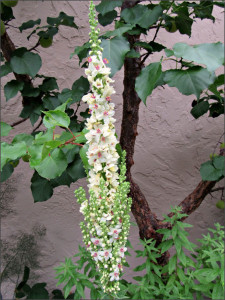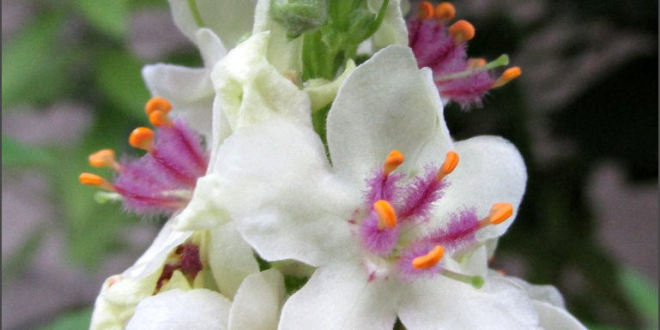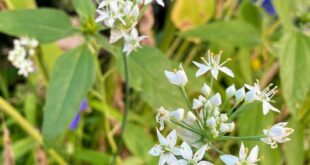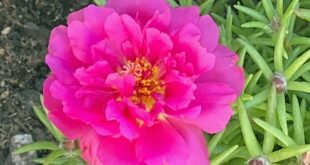We first planted our verbascum in October 2014. It had a late season flowering. In June 2015, it bloomed again. Do not plant other things within 2 feet of it as it has large leaves. Erect stems bearing profuse saucer-shaped flowers that are usually yellow, but also white, brownish-red, or purple. Individual flowers are short lived but numerous, and flowering takes place over a long time. Most plants in the genus Verbascum are biennials or short lived perennials and a few are annuals; some have semi-evergreen or evergreen rosettes. Most species self-sow, but not as a nuisance, and many seedlings vary slightly from the parent cultivar, thereby creating welcome surprises. Most species are found on dry, stony hillsides and open woodlands, but different species are well-adapted to cottage, gravel, rock gardens, or naturalized areas.
Noteworthy characteristics: Tall, upright flower spikes with small bright flowers bloom over a long period and create vertical accents in the garden. Leaves are often fuzzy and cast with a silvery sheen.
Care: Fuzzy-leaved species prefer full sun, others will tolerate partial shade. Grow in any well-drained soil. Verbascums tend to flop in fertile soil.
Propagation:
Sow seeds of annuals and biennials in spring in containers under a cold frame. Divide in spring. Take root cuttings in winter. Take semi-ripe cuttings of shrubby species in late winter.
Follow us: @finegardening on Twitter | FineGardeningMagazine on Facebook

Details
Family: Scrophulariaceae (skrof-yoo-larr-ee-AY-see-ee) (Info)
Genus: Verbascum (ver-BASK-um) (Info)
Species: chaixii (kay-IKX-ee-eye) (Info)
Category: Perennials
Height: 36-48 in. (90-120 cm)
Spacing: 15-18 in. (38-45 cm)
Hardiness:
USDA Zone 5a: to -28.8 °C (-20 °F)
USDA Zone 5b: to -26.1 °C (-15 °F)
USDA Zone 6a: to -23.3 °C (-10 °F)
USDA Zone 6b: to -20.5 °C (-5 °F)
USDA Zone 7a: to -17.7 °C (0 °F)
USDA Zone 7b: to -14.9 °C (5 °F)
USDA Zone 8a: to -12.2 °C (10 °F)
USDA Zone 8b: to -9.4 °C (15 °F)
USDA Zone 9a: to -6.6 °C (20 °F)
USDA Zone 9b: to -3.8 °C (25 °F)
Sun Exposure: Full Sun
Danger: Unknown – Tell us
Bloom Color: Rose/Mauve; Pale Yellow
Bloom Time: Mid Summer Late Summer/Early Fall
Foliage: Herbaceous
Other details: Average Water Needs; Water regularly; do not overwater
Soil pH requirements: 6.1 to 6.5 (mildly acidic); 6.6 to 7.5 (neutral)
Patent Information: Non-patented
Propagation Methods: By dividing the rootball
From seed; winter sow in vented containers, coldframe or unheated greenhouse
From seed; sow indoors before last frost
From seed; direct sow after last frost
Seed Collecting: Allow seedheads to dry on plants; remove and collect seeds
Read more: http://davesgarden.com/guides/pf/go/850/#ixzz3GijiKjyt








